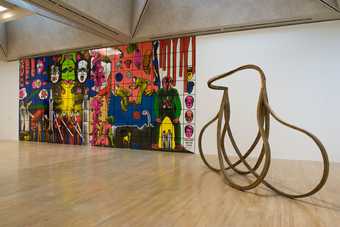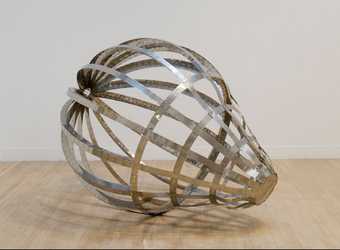
Installation view of Turner Prize: a Retrospective exhibition
Photo: Tate Photography © Tate 2007
During this period the Turner Prize evolved in response to criticism from the press, artists and arts professionals. While the exhibitions consistently reflected a wide range of practices, discussion of the work was continually overshadowed by concern about the politics of the prize. Some argued that the conditions for nomination were too vague. Others felt that the very idea of a shortlist was invidious.
There was disapproval of the nomination of curators and critics alongside artists, and a sense of unease about the way that established senior artists were pitted against relative newcomers. All of the winning artists displayed in the gallery here were nominated in 1984 and later went on to win the prize, which led to accusations of ‘insider’ art world predictability.
Artists and works on display:
Howard Hodgkin
D.H. In Hollywood 1980–4
Oil on wood
Private collection, London
A Small Thing But my Own 1983–5
Oil on wood
Private collection
Hodgkin works from memory to convey the psychological and physical intensity of specific encounters. In D.H. In Hollywood he pays homage to his friend, the artist David Hockney. He introduced his signature motif of painting over the picture frame in the early 1970s, reinforcing the works as objects.
Throughout the 1980s Hodgkin experimented with scale, varying the size and format of each painting according to the nature of the subject. A Small Thing But my Own was first exhibited in the 1985 Turner Prize, the year that Hodgkin won.
Gilbert & George
Drunk with God 1983
Mixed media
Ludwig Museum, Cologne
Since 1980 Gilbert & George’s photographic works have become the main vehicle for their meditations on the social and spiritual condition of contemporary urban man.
Drunk with God was exhibited in the inaugural Turner Prize exhibition in 1984 and presents an epic, cosmic vision of the world, where the artists are cast as both observers and creators. The work features motifs that have appeared throughout their practice: the flower – a symbol of sex and fecundity, and East End youths – icons of ideal manhood.
Richard Deacon

Richard Deacon
For Those Who Have Eyes 1983
Donald Fisher, San Francisco
© the artist
For Those Who Have Ears #2 1983
Laminated wood and adhesive
Tate
For Those Who Have Eyes 1983
Stainless steel
Donald Fisher, San Francisco
Both of these works stem from an earlier series of drawings that Richard Deacon based on The Sonnets to Orpheus 1922 by poet Rainer Maria Rilke. These forms are reminiscent of apertures or openings, suggesting eyes, ears, mouths and genitalia – vessels of the senses that channel our perceptions of the world.
For Deacon, the layering of laminates invokes ideas of resonance, of sound produced and sound heard. The shiny stainless steel reflects the seen (and photographed), indicated by the iris-like closure at one end of this work.
